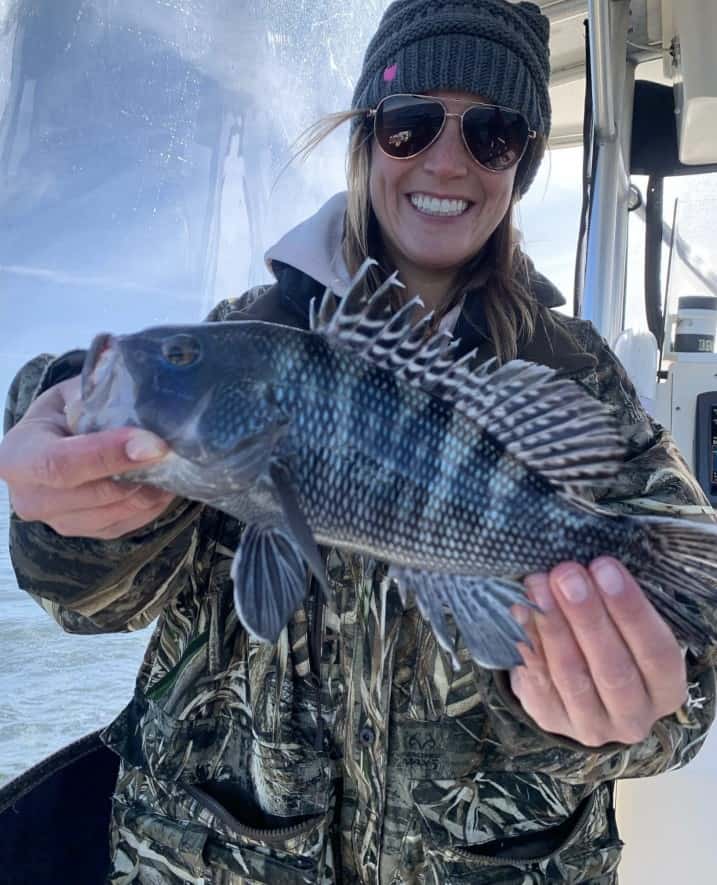Sporting Life

Knotheads Swarm the Chesapeake
By Dennis Doyle
His rod tip dipped once, then again and he set the hook. The rod arced over and line pulled off his reel as the fish below raced for some kind of exit. Surprised, Charlie reached to loosen the drag knob but, too late, a slight ping announced the fish’s victory. All the angler could do was shake his head. This December day on the Chesapeake already seemed like another world.
The black sea bass is one of the most pursued fish of the ocean. Not widely known for its sporting aspects, though it does have them, the fish is one of the most delicious of the many species swimming the Atlantic. Described as a protogynous hermaphrodite, all black sea bass begin life as female and can morph into male and back to female as gender population balances fluctuate. In their male phase they often sport a pronounced bulge in front of their shoulders, giving them the nickname knotheads.
Generally found in the near offshore ocean depths to 200 feet, the species has become a bellwether for climate change migration. As our waters warm, these fish are being found in ever more locations they were not previously known for visiting. This year as our salinity as well as the water temperatures have increased, they’ve advanced well up into the Chesapeake in remarkable numbers.
I’ve been sworn to secrecy concerning this particular location, their table value (firm, sweet, white meat fillets) overwhelms the normal tendency of most marine sports to share in good news. But the four-person party of Charlie, LJ, Sam and Lyndsie, were fishing well up in the Chesapeake, boasting over 60 fish just last week, though not all were of legal length (12½ inches).
Black sea bass can live 20 years or more and reach eight pounds in size but two pounders are more the norm for sports angling, however. Consider that two anglers that day also lost bass they described as unusually powerful. A 15-incher is considered an excellent size for the species but bigger bass can pull like the devil itself.
The depths these particular fish were holding was in the 60- to 80-foot range but the species can be located in as little as 20 feet during the spring. Fingerlings remain close inshore and in estuary waters until they reach survivable sizes. Once mature, though, the deeper the water, the bigger the bass tend to be. The biggest fish are frequently encountered in depths over 100 feet.
Jigging near the Bay bottom with one to one and half ounce jig heads rigged with four-inch Gulp Swimming Mullet tails and sporting a smaller half ounce Gulp Tail Dropper jig were most effective that day. The action for this party was consistently excellent over three hours until the tidal current picked up and dispersed the school.
It wasn’t the first time that numbers of these fish have been located well into the Chesapeake. Reliable reports of fantastic bites in the mid-Bay area have been surfacing for the last three months and many sizeable fish have been included in the bags of the lucky anglers.
The sea bass frequenting the Bay, similar to their oceanic brethren, have shown a definite propensity to school over and near deep water structures, wrecks and large rock piles but they can also be found in transition areas near deep drop-offs and channel cuts. They feed on small fish, minnows, crab, squid, shrimp, barnacles, small bivalves and worms and have needle sharp fin spines and sharp gill covers. Large mouthed with small pointed teeth, they are well equipped to deal with anything appearing edible.
Fishfinder:
Rockfish season closes today, December 10, but hardy anglers are getting some big white perch near the Bay Bridge and at the mouth of the Eastern Bay on bloodworms at 40 feet. The black sea bass bite is a surprise but locations have been hard to come by. Stay warm, baby it’s cold outside.
